82% of American adults own a cell phone, Blackberry, iPhone or other device that is also a cell phone.
Texting by adults has increased over the past 9 months from 65% of adults sending and receiving texts in September 2009 to 72% texting in May 2010. Still, adults do not send nearly the same number of texts per day as teens ages 12-17, who send and receive, on average, 5 times more texts per day than adult texters.
- Adults who text typically send and receive a median of 10 texts a day; teens who text send and receive a median of 50 texts per day.
- 5% of all adult texters send more than 200 text messages a day or more than 6,000 texts a month. Fully 15% of teens 12-17, and 18% of adults 18 to 24 text message more than 200 messages a day, while just 3% of adults 25 to 29 do the same.
- Heavy adult texters – those who send and receive more than 50 texts day — also tend to be heavy users of voice calling. Light texters, who exchange 1 to 10 texts a day, do not make up for less texting by calling more. Instead, they are light users of both calling and texting.
The original purpose of the cell phone is still the most universal – nearly every cell phone user makes calls on their phone at least occasionally.
- The average adult cell phone owner makes and receives around 5 voice calls a day.
- Women tend to make slightly fewer calls with their cell phones than men – while 53% of women make and receive 5 calls or fewer per day, 43% of men say the same. Men are a bit more likely to make slightly more phone calls in a day; 26% of men send and receive 6 to 10 calls a day, while 20% of women exchange that many calls. Men and women are equally likely to be represented at the extreme high end of callers with 8% of men and 6% of women making and taking more than 30 calls a day.
Americans especially appreciate that their cell phones make them feel safer (91% of cell owners say that) and help them connect to friends and family to arrange plans (88% agree). Still, some users express irritation with their phone for the disruptions it creates, though the heaviest users of the phone are no more likely to express irritation with their phone than lower level users. Two in five (42%) cell-owners say they feel irritated when a call or text interrupts them. Cell phones are such a vital part of American’s lives that many users will not be parted from their device, even as they sleep:
- 65% of adults with cell phones say they have ever slept with their cell phone on or right next to their bed.
- Adults who have slept with or near their phones are also more likely to feel positively about their phone. They are more likely to appreciate the way the phone helps them to make plans (94% vs. 78% of those who don’t sleep with their phone) and to see the phone as a source of entertainment (52% vs. 14%). Phone sleepers are just as likely to express irritation with the phone as those who don’t sleep near their handset.
Spam isn’t just for email anymore; it comes in the form of unwanted text messages of all kinds – from coupons to phishing schemes – sent directly to user’s cell phones.
- 57% of adults with cell phones have received unwanted or spam text messages on their phone.
African American and Hispanic cell users are more intense and frequent users of all of the phone’s capabilities than whites. Minorities send more text messages and make more calls on average than their white counterparts.
- African American and English-speaking Hispanic adults are slightly more likely than whites to own a cell phone, with 87% of African-Americans and English speaking Hispanics owning a phone, compared with 80% of whites.
- African American and English-speaking Hispanic cell phone owners are more likely than whites to initiate and receive large numbers of calls each day. One in eight (12%) African-American phone owners and 14% of Hispanic cell users make and receive more than 30 calls on a typical day, while just 4% of white cell phone users make and receive the same number of calls.
- African American and Hispanic texters typically text more on average than white texters, with a median of 10 texts a day for African-Americans and Hispanics and 5 texts a day for whites. White adults are a bit more likely than English-speaking Hispanic adults to say they do not send or receive any texts on a typical day (10% vs. 4% respectively).
Parents with children under 18 in the home are also keen users of the cell phone. Parents are more likely to own a cell phone than non-parents, and more likely to make 5 or more calls per day than non-parents (63% vs. 44%), though they do not text more overall. They are more likely to have slept with their phone on or near their bed, and to use the phone for talking for all types of purposes. Texting is less definitive – mostly parents use it for the same reasons and similar frequencies as non-parents. Parents are also more likely than those without minor children at home to appreciate the way the phone allows them to check in, plan on the fly and stave off boredom.
- 90% of parents are more likely to have a cell phone than adults without children under 18 at home (78%).
- 72% parents have slept with their phone, compared to 62% of non-parents.
- Parents are more likely to use their cell phone’s voice capabilities several times a day for work calls, (32% of parents vs. 19% of non-parents) to check in with someone (28% vs. 17%), to say hello and chat (31% vs. 24%) and to have long personal conversations (13% vs. 7%). Parents are more likely than non-parents to coordinate a physical meeting (18% vs. 13%) daily.
Cell ownership in the United States remains steady since 2009
Cell phones have moved beyond fashionable accessory and into the realm of life necessity – just as many adults have a cell phone as have a computer. Cell phones are now toted by more than four in five American adults (82%). Cell phone ownership is up from 65% of American adults in November 2004, but has remained steady since 2009. More adults have a cell phone than have an iPod or mp3 player (46%) or e-Book reader (4%), and just as many adults have a computer (79% have a laptop or desktop) as have a mobile phone. One third (35%) of those who do not own a cell phone live in households where someone else has a cell phone.
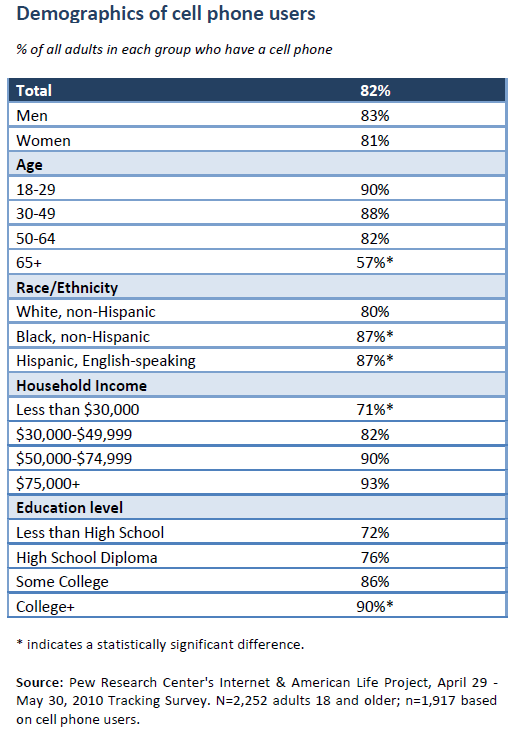
Black and English-speaking Hispanic1 adults are slightly more likely than whites to own a cell phone, with 87% of African-Americans and Hispanics owning a phone, compared with 80% of whites. Young adults are much more likely than older ones to own a cell phone – with the youngest most likely to own a cell phone and the oldest adults the least likely to own one. Those with higher levels of education and annual household income are also more likely to possess a cell phone. Parents, with their logistics-heavy lives, are more likely to have a cell phone than adults without minor children in the home (90% vs. 78%). People who live in rural areas (72%) are also less likely to have a cell phone than those who live in suburban (82%) or urban areas (85%). Further, internet users and those with home broadband are substantially more likely to use cell phones than those who do not go online and do not have broadband at home. Nevertheless, more than half (53%) of adults who do not use the internet at all have a cell phone.
Uses of the phone: Calling and texting
Two of the main uses of the cell phone are voice calling and text messaging.2 While nearly all adult users of the cell phone make phone calls, 72% of adults 18 and older with cell phones send and receive text messages, up from 58% of phone-owning adults who texted in December 2007.
Adults send and receive about 10 texts a day.
Among the nearly three quarters of adults with phones who text, the average user sends and receives 10 texts a day, up from an average of 5 texts a day just 8 months earlier in September 2009. Breaking it down by number of texts, half (51%) of adult texters send between 1 and 10 texts a day. Another 25% of adults send 11 to 50 texts a day, and 10% send between 50 and 200 texts a day. Just 4% of adults send more than 200 text messages a day or more than 6,000 texts a month.
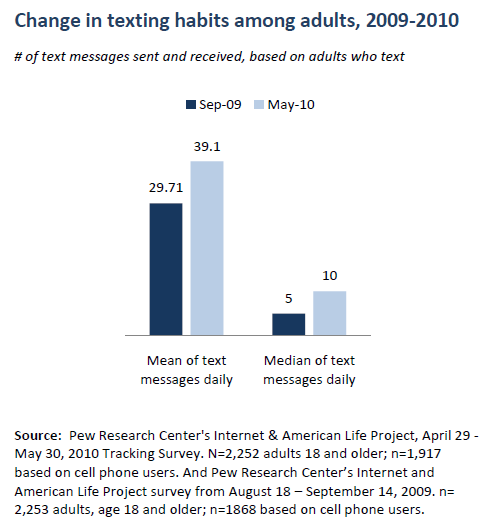
Younger adults who text report sending more text messages a day than older adults. While 88% of adults 50 and older send 10 or fewer texts a day, just 50% of adults younger than 50 say the same. The very youngest adults text most similarly to their teenage counterparts — having just left their teen years themselves. Fully 18% of adults 18 to 24 text message more than 200 messages a day, as do 15% of teens 12-17, while just 3% of adults 25 to 29 do the same.
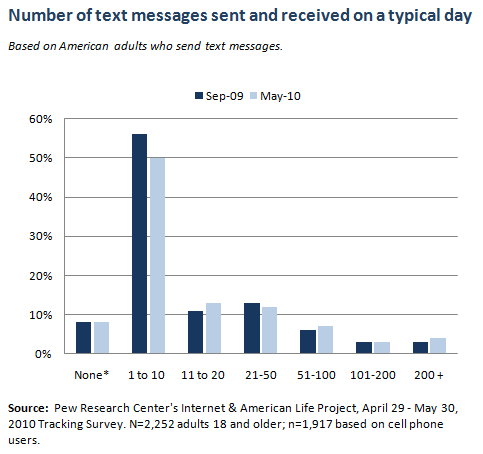
There are no gender differences in numbers of text messages sent daily – men and women do this equally. There are also modest differences by race or ethnicity in text messaging. African-American and Hispanic texters typically text more on average than white texters, with a median of 10 texts a day for African-Americans and Hispanics and 5 texts a day for whites. White texters are a bit more likely than English-speaking Hispanic adults to say they do not send or receive any texts on a typical day (10% vs. 4% respectively).
Heavy texters – those who send and receive more than 50 texts day — also tend to be heavy users of voice calling. Light texters, who exchange 1 to 10 texts a day, do not make up for less texting by calling more; instead they are light users of both communicative aspects of the cell phone – making fewer calls and sending fewer texts. Fully 63% of cell owners who don’t text make and receive 1 to 5 calls a day, while just 21% of heavy texters engage in the same amount of voice calling. On the other side, 26% of heavy texters make and receive 31 or more calls a day, while just 1% of phone owners who do not text make and receive the same large number of calls.
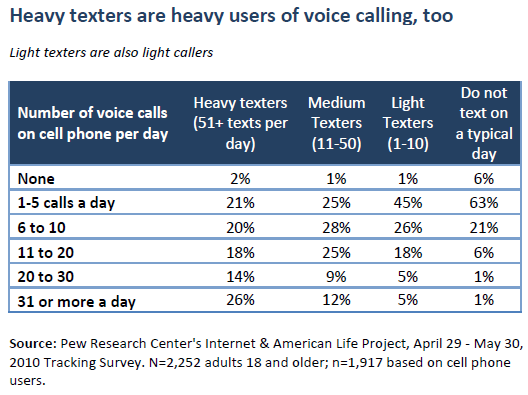
The average adult cell phone owner makes and receives around 5 voice calls a day.
Overall, the largest segment (44%) of cell-owning adults makes 1 to 5 calls on a typical day. Only 5% of adults say they do not make or receive any calls on their cell phone on an average day.
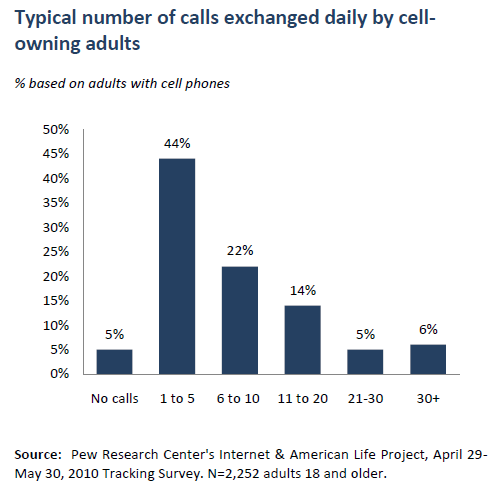
Women report making fewer calls with their cell phones on average than men.
Women make slightly fewer voice calls than men – while 53% of women make and receive 5 calls or less per day, 43% of men say the same. One fifth (21%) of men make or receive 11-30 calls per day, while 17% of women say the same. African American and English-speaking Hispanic cell phone owners are more likely than whites to initiate and receive large numbers of calls each day. On average, African American and Hispanic cell phone users make and receive 10 calls on a typical day,3 while White cell owners average 5 calls placed and received daily. One in eight (12%) of African American phone owners and 14% of Hispanic cell users make and receive more than 30 calls on a typical day, while just 4% of white cell phone owners make and receive the same number of calls.
In a typical behavior pattern for all manners of cell phone use, younger adults are more likely than older adults to make and receive a large number of calls per day. Fully 12% of adults between 18 and 29 years old engage in more than 30 cell phone calls per day, while just 7% of 30 to 49 year olds do so. By comparison, just 3% of 50 to 64 year olds and 1% of those 65 years old and older make more than 30 calls per day on their cell phone. More than half of adults 50 and older initiate and receive 5 or fewer calls per day, while the majority of users under 50 make and receive 6 or more calls a day. Parents are also more likely to make more phone calls on a typical day; 63% of parents make more than 5 calls a day compared with 44% of adults without children under 18 at home.
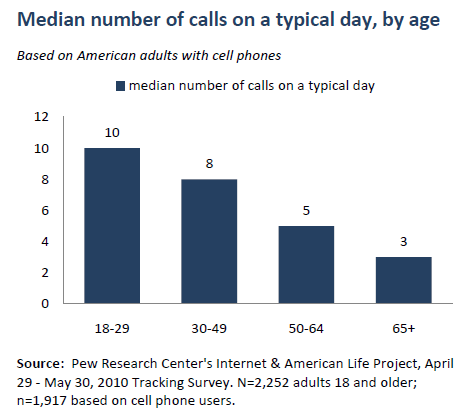
Two-thirds of adults sleep with their cell phone
As the cell phone becomes more central to lives of American adults and teens, users are increasingly reluctant to be parted from their device, even at night. Fully two-thirds (65%) of adults say they have slept with their cell phone on or right next to their bed. Those who send text messages, and in particular heavy texters (sending and receiving more than 51 texts a day) and medium texters (11 to 50 texts a day) are more likely to sleep with their phones than lighter texters or those who do not text. Heavy users of voice calling on the cell phone, and daily users of the cell phone for internet access are also more likely to sleep with their phones.
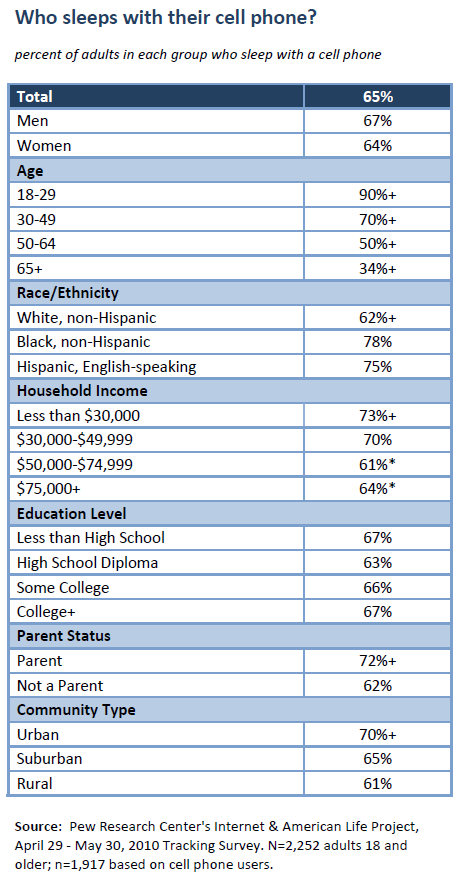
Younger adults with cell phones ages 18-29 are the most likely to have ever slept with or next to their phone of all age cohorts with fully 90% of young adults with cell phones saying they have slept with their phone. By comparison, 70% of 30 to 49 year olds with phones sleep with their handset, as do 50% of 50 to 64 year olds and just one third 34% of those 65 and older with cell phones. African-Americans and English-speaking Hispanic cell phone owners are also more likely to sleep with their phone than their white counter parts, with 78% of African-Americans and 75% of Hispanics sleeping with their phones, while 62% of whites bunk with their phone.
Lower income adults – those earning under $30,000 annually – are also more likely to have slept with their phone, as are parents, of whom 72% sleep with their phone, compared with 62% of non-parents. Cell phone users who live in urban areas are also more likely to sleep with their cell phone on or next to their bed than others.
Adults who have ever slept with or near their phones are also more likely to feel positively about their phone. They are more likely to say that they like the way it helps them arrange plans. However, they are just as likely as those who do not curl up at night with their phone to say that they are irritated by phone-instigated interruptions and by the way others check their phones during meetings or conversations. And they are more likely than other adult cell phone users to say that they use the phone to fight boredom – similar to teens’ reported use of the phone for entertainment and reflective of the greater youth of those who sleep with their phone.
More than half of cell-owners receive unwanted text messages
Spam isn’t just for email anymore; 57% of adults with cell phones have received unwanted or spam text messages on their phone. Men are a bit more likely to have received spam texts than women, and those with some college or a college degree are more likely to report having received unwanted texts. Heavy texters and medium texters (11 or more texts a day), and cell users who go online on their phones daily are more likely to receive unwanted texts than those who text less or use their cell phone to access the internet infrequently. Cell phone texters who are more highly connected in other ways – with wireless internet access or broadband at home – are also more likely to receive spam texts. Voice usage on a cell phone does not relate to the likelihood of receiving spam text messages.




